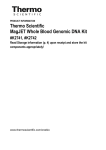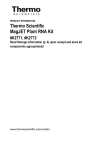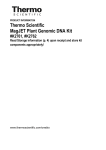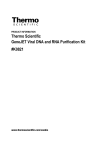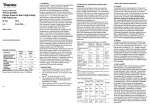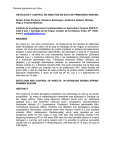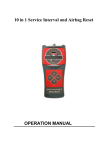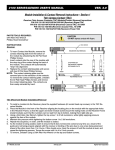Download Product information: MagJET Genomic DNA Kit, #K2721, #K2722
Transcript
PRODUCT INFORMATION Thermo Scientific MagJET Genomic DNA Kit #K2721, #K2722 #K2721, #K2722 Lot 00000000 Expiry Date 00.0000 Read Storage information (p. 4) upon receipt and store kit components appropriately! CERTIFICATE OF ANALYSIS Thermo Scientific™ MagJET™ Genomic DNA Kit is qualified by isolating genomic DNA from 5 mg of mouse liver following the protocols outlined in the manual. The quality of purified genomic DNA is evaluated spectrophotometrically and by agarose gel electrophoresis. The purified genomic DNA has an A260/A280 ratio of 1.8 ± 0.2. The functional quality of purified DNA is evaluated by digestion with restriction endonucleases. Quality authorized by: Rev.1 Jurgita Žilinskienė N www.thermoscientific.com/onebio 2 CONTENTS COMPONENTS OF THE KIT #K2721 MagJET Genomic DNA Kit 96 preps Proteinase K 2 × 1.2 mL Digestion Solution for MagJET gDNA Kit 22 mL Lysis Buffer for MagJET gDNA Kit 35 mL MagJET Magnetic Beads 2 × 1.4 mL RNase A 2 × 1.2 mL Wash Buffer 1 (conc.) for MagJET gDNA Kit 25 mL Wash Buffer 2 (conc.) for MagJET gDNA Kit 50 mL Elution Buffer 30 mL page COMPONENTS OF THE KIT ..............................................................................................................................4 STORAGE...........................................................................................................................................................4 DESCRIPTION....................................................................................................................................................4 PRINCIPLE .........................................................................................................................................................4 IMPORTANT NOTES ..........................................................................................................................................5 ADDITIONAL MATERIALS AND EQUIPMENT REQUIRED ...............................................................................6 STARTING MATERIAL HANDLING AND STORAGE .........................................................................................6 PROTOCOL SELECTION GUIDE ......................................................................................................................7 GENOMIC DNA PURIFICATION PROTOCOLS AND PIPETTING INSRUCTIONS ...........................................8 Protocol A. Instructions for genomic DNA purification from up to 106 cultured mammalian cells using KingFisher Flex 96 and Microtiter deep well 96 plates. ...................................................................................8 Protocol B. Instructions for genomic DNA purification from up to 20 mg of tissue, rodent tail and insects using KingFisher Flex 96 and Microtiter deep well 96 plates .........................................................................10 Protocol C. Instructions for genomic DNA purification from up to 106 cultured mammalian cells using KingFisher Duo and Microtiter deep well 96 plates .......................................................................................11 Protocol D. Instructions for genomic DNA purification from up to 20 mg tissue, rodent tail and insects using KingFisher Duo and Microtiter deep well 96 plates .......................................................................................13 Protocol E. Instructions for manual genomic DNA purification from up to 20 mg tissue, rodent tail and insects. ..........................................................................................................................................................14 Protocol F. Instructions for manual genomic DNA purification from up to 106 cultured mammalian cells ......15 Protocol G. Instructions for genomic DNA purification from gram-negative bacterial cultures (up to 109 cells) .............................................................................................................................................15 Protocol H. Instructions for genomic DNA purification from yeast culture (up to 108 cells) ............................16 Protocol I. Instructions for genomic DNA purification from blood leucocytes .................................................17 Protocol J. Instructions for genomic DNA purification from urine sediments .................................................18 Protocol K. Instructions for genomic DNA purification from urogenital swabs ...............................................19 Protocol L. Instructions for genomic DNA purification from human buccal cells ............................................20 Protocol M. Instructions for genomic DNA purification from saliva ................................................................21 Protocol N. Instructions for genomic DNA purification from hair follicles .......................................................22 Protocol O. Instructions for genomic DNA purification from milk ...................................................................23 TROUBLESHOOTING ......................................................................................................................................24 SAFETY INFORMATION ..................................................................................................................................25 STORAGE Proteinase K solution is stable at room temperature as long as the vial remains sealed. After being opened it should be stored at -20°C. When the kit is delivered, remove the RNase A from the package and store at -20°C. MagJET Magnetic Beads should be stored at 4°C. For longer use, it is recommended to aliquot Elution Buffer as 1-2 mL samples and store at -20°C. Other components of the kit should be stored at room temperature (15-25°C). DESCRIPTION The MagJET Genomic DNA Kit is designed for fast and efficient purification of genomic DNA from tissue and cell cultures, bacteria and yeast, as well as from human body samples, such as buccal and urogenital swabs, urine, saliva and hair follicles. The kit utilizes paramagnetic bead technology enabling high yields and robust performance. High binding capacity, uniform particle size, and rapid magnetic response of MagJET magnetic beads makes the technology ideal for high throughput automatic nucleic acid purification, as well as for manual purification for low sample throughput. The resulting high quality DNA is free of proteins, nucleases and other contaminants or inhibitors, and can be used in a wide range of downstream applications such as PCR, qPCR or other enzymatic reactions. See Table 1 for typical genomic DNA yields from various sources. PRINCIPLE The MagJET Genomic DNA Kit uses the highly efficient MagJET magnetic particle-based technology for nucleic acid purification. The whole nucleic acid isolation process combines simple steps of sample lysis, DNA binding to the magnetic beads, washing and elution. Purification protocols optimized for automated KingFisher instruments utilize a high throughput magnetic bead transfer technique where magnetic beads are transferred through different reagent plates containing lysis, binding, washing and elution reagents. This enables high throughput nucleic acid purification and eliminates multiple pipetting steps. Alternatively, a protocol is available where buffers and other reagents are transferred in each of the protocol steps, while magnetic beads remain captured on the wall of the tube using a magnetic rack. This allows the kit to be used for various throughput applications using a magnetic rack and manual or automated pipetting equipment. 3 #K2722 384 preps 8 × 1.2 mL 90 mL 135 mL 10.6 mL 8 × 1.2 mL 2 × 50 mL 4 × 50 mL 2 × 30 mL 4 Table 1. Typical genomic DNA yields from various sources. Source Quantity 5 mg 1 Mouse heart 20 mg 5 mg 2 Mouse tail (homogenized) 20 mg 5 mg 3 Mouse tail (cut) 20 mg 5 mg 4 Mouse liver 20 mg 5 mg 5 Mouse spleen 20 mg 5 mg 6 Mouse kidney 20 mg 5 mg 7 Mouse muscle 20 mg 5 mg 8 Mouse brain 20 mg 5 mg 9 Mouse skin 20 mg 5 mg 10 Mouse lung 20 mg 5 mg 11 Mouse ear 20 mg 12 E. coli cells 2 × 109 cells 13 S. cerevisiae 108 cells 14 HeLa cells 106 cells 15 Jurkat cells 106 cells 16 COS-7 cells 106 cells 17 Human blood leucocytes leucocytes collected from 1 mL of blood DNA yield 4.5 µg 18-19 µg 6 µg 15 µg 1 µg 4-5 µg 14-15 µg 50 µg 20 µg 72-75 µg 9-10 µg 35-38 µg 2.5 µg 8-9 µg 3 µg 10.5-11 µg 5 µg 18-19 µg 9-10 µg 36-38 µg 9.5 -10 µg 35-37 µg 13-17 µg 7-11 µg 7-11 µg 6-12 µg 3-5 µg 13-17 g IMPORTANT NOTES Add the indicated volume of ethanol (96-100%) to Wash Buffer 1 (conc.) and Wash Buffer 2 (conc.) prior to first use: 96 preps 384 preps Wash Buffer 1 Wash Buffer 2 Wash Buffer 1 Wash Buffer 2 Concentrated buffer 25 mL 50 mL 50 mL 50 mL Ethanol (96-100%) 75 mL 150 mL 150 mL 150 mL Total volume: 100 mL 200 mL 200 mL 200 mL After preparing each solution, mark the bottle to indicate that this step has been completed. Check all solutions in the kit for any salt precipitation before each use. Re-dissolve any precipitates by warming the solution at 37°C, and then equilibrate to room temperature (15-25°C). Wear gloves when handling the Lysis Buffer and Wash Buffer 1 as these reagents contain irritants (see page 25 for SAFETY INFORMATION). Buffers For mammalian cell lysate preparation: a) PBS (137 mM NaCl, 2.7 mM KCl, 10 mM Na2HPO4, 2 mM KH2PO4, pH 7.4). b) 0.15 M NaCl solution. c) TE buffer (10 mM Tris-HCl, pH 8.0, 1 mM EDTA). For gram-positive bacteria lysate preparation: Gram-positive bacteria lysis buffer (20 mM Tris-HCl, pH 8.0, 2 mM EDTA, 1.2% Triton X-100, add lysozyme to 20 mg/mL immediately before use). For yeast lysate preparation: Yeast lysis buffer (5 mg/mL Zymolyase 20T, 1 M sorbitol, 0.1 M EDTA). For red blood cells lysis: RBC buffer (10X buffer: 1.68 M NH4Cl, 2 mM EDTA). STARTING MATERIAL HANDLING AND STORAGE To minimize DNA degradation, avoid repeated freeze/thaw cycles of the samples and perform extractions from fresh material, or material that has been immediately frozen and stored at -20°C or -70°C. Appropriate sample storage is essential for reproducibility and high DNA yields. Yields of DNA may vary depending on sample age, type of sample, and storage conditions. Yield of DNA purified from different types of tissue depends on efficiency of homogenization when grinding tissues, tails, insects or skin samples in liquid nitrogen using a mortar and pestle. Disruption of tissue or rodent tail samples into small pieces using knives, scissors or homogenizers results in 2-5 times reduced yield of DNA in comparison with grinding in liquid nitrogen. For qualitative and quantitative DNA purification, incubation of tissue lysates with Proteinase K up to 1 or 2 hours is sufficient. Extension of the hydrolysis procedure with Proteinase K up to 6 or 16 hours (overnight) does not increase yield and quality of purified DNA. 5 ADDITIONAL MATERIALS AND EQUIPMENT REQUIRED Pipettes and pipette tips. 1.5-2 mL plastic tubes. Vortex. Microcentrifuge. Disposable gloves. 96-100% ethanol, molecular biology grade. Equipment for sample disruption and homogenization (depending on the method chosen): Mortar and pestle. Homogenizer. Automatic magnetic particle processor and consumables. Magnetic particle processing rack. 6 KingFisher Flex Instrument KingFisher Duo Instrument Manual processing ● - - Protocol A page 8 24 - ● - Protocol C page 11 variable - - ● Protocol F page 15 96 ● - - Protocol B page 10 24 - ● - Protocol D page 13 variable - - ● Protocol E page 14 variable ● ● ● Protocol G page 15 Plate number variable ● ● ● Protocol H page 16 1 variable ● Protocol I page 17 variable ● ● ● Protocol J page 18 - variable ● ● ● Protocol K page 19 - variable ● ● ● Protocol L page 20 - variable ● ● ● Protocol M page 21 8-10 follicles Up to 0.2 mL variable ● ● ● Protocol N page 22 variable ● ● ● Protocol O Page 23 Mammalian cell culture up to 106 cells Yeast culture Blood leucocytes Urine sediments Urogenital swabs Buccal cells Saliva Hair follicles Milk Note: When using the MagJET Genomic DNA Kit for the first time, prepare working solutions of Wash Buffer 1 and Wash Buffer 2 as described on page 5. Transfer the Tissue_gDNA_Flex protocol file to the KingFisher Flex as described on page 7. 1. Collect the Cultured Mammalian Cells as follows: a) Suspension cells Pellet up to 106 cells in an appropriate centrifuge tube for 5 min at 300 × g. Discard the supernatant. Rinse the cells once with PBS to remove residual growth medium. Repeat the centrifugation step and discard the supernatant. b) Adherent cells Remove growth medium from the cells (use up 106 cells). Rinse the cells once with PBS to remove residual medium. Remove and discard PBS. Detach the cells from the culture plate by scraping in an appropriate volume of PBS or by trypsinization. Transfer the cells into a microcentrifuge tube (not included) and pellet by centrifugation for 5 min at 300 × g. Discard the supernatant. 2. Resuspend the cells collected in 40 μL of 0.15 M NaCl solution; add 200 μL of Digestion Solution and 20 μL of Proteinase K Solution. Mix the cell lysate thoroughly by vortexing or pipetting to obtain a uniform suspension. Incubate the sample at 56°C while vortexing occasionally or use a shaking water bath, rocking platform or thermomixer until the cells are completely lysed (20-30 minutes). 3. Obtain four Thermo Scientific Microtiter deep well 96 plates and one Thermo Scientific KingFisher Flex 96 KF plate. 4. Add the following reagents to the plates and leave the plates at room temperature while the Sample plate is being prepared. 96 Sample quantity Bacterial culture Protocol A. Instructions for genomic DNA purification from up to 106 cultured mammalian cells using KingFisher Flex 96 and Microtiter deep well 96 plates. MagJET purification protocol Sample type Tissue, rodent tail and insects GENOMIC DNA PURIFICATION PROTOCOLS AND PIPETTING INSRUCTIONS Throughput per run PROTOCOL SELECTION GUIDE The MagJET Genomic DNA Kit provides optimized protocols for genomic DNA purification from different amounts of starting material (up to 106 cells and up to 20 mg tissue). The kit is compatible with automated and manual sample processing, allowing low- to high-throughput nucleic acid purification workflow. The following selection guide summarizes available protocols depending on starting sample quantity, throughput and sample processing type. Automation protocols are optimized for KingFisher Flex and KingFisher Duo instruments. Transfer the Tissue_gDNA_Flex protocol file to the KingFisher Flex or Tissue_gDNA_Duo protocol file to the Kingfisher Duo instrument before first use. The instructions for transferring the protocol can be found in Chapter 4: “Using the software” in the BindIt Software for KingFisher Instruments version 3.2 User Manual. The protocol files for MagJET Genomic DNA Kit can be found on product web page on www.thermoscientific.com/onebio. up to 20 mg 109 up to cells up to 108 cells collected from 1 mL of blood from 20-25 mL urine ● ● Page 2 Microtiter deep well 96 plate Content Volume per well Isopropanol (100%) 400 µL Magnetic Beads* 25 µL Wash 1 Wash Buffer 1 (supplemented with ethanol) 800 µL Wash 2_1 Wash Buffer 2 (supplemented with ethanol) Wash Buffer 2 (supplemented with ethanol) Elution buffer Wash 2_2 4 5 Plate name Sample 3 KingFisher Flex 96 KF plate Elution * Resuspend Magnetic Beads well by vortexing before use. 7 Plate type 8 800 µL 800 µL 150 µL 5. Prepare the sample plate as follows: after cells have been incubated with Proteinase K, add 20 μL of RNase A Solution, mix by vortexing then incubate for 10 minutes at room temperature. Add 300 μL of Lysis Buffer, vortex 5-10 seconds and transfer lysates to Sample plate (prefilled by 400 µL of isopropanol and 25 µL of magnetic beads). 6. Place a Thermo Scientific KingFisher Flex 96 tip comb for deep well magnets on a Tip Plate (empty KingFisher Flex 96 KF plate). 7. Start the Tissue_gDNA_Flex protocol on the KingFisher Flex 96 and load the plates according to the KingFisher display. After all the plates have been loaded into the instrument, the protocol will begin. 8. When the protocol is completed, remove the plates according to the instructions on the KingFisher Flex display and turn off the instrument. The purified gDNA is ready for use in downstream applications. Use the purified gDNA immediately or store it at -20°C. Protocol B. Instructions for genomic DNA purification from up to 20 mg of tissue, rodent tail and insects using KingFisher Flex 96 and Microtiter deep well 96 plates Note: When using the MagJET Genomic DNA Kit for the first time, prepare working solutions of Wash Buffer 1 and Wash Buffer 2 as described on page 5. Transfer the Tissue_gDNA_Flex protocol file to the KingFisher Flex as described on page 7. 1. Grind up to 20 mg of mammalian tissue, 0.5 cm (mouse) tail clip, or up to 20 mg of insect in liquid nitrogen using a mortar and pestle. Alternatively, cut the tissue into small pieces or disrupt it using a homogenizer. Note: For spleen and lung tissue use up to 5 mg. High quantities of DNA (2-4 µg/mg tissue) from indicated tissues result in high viscosity of eluates and contamination by magnetic beads. Using 200 µL (instead of 150 µL) Elution Buffer in step 5 is also recommended when isolating DNA from 5 mg spleen or lung tissues. 2. Collect the material into a 2.0 mL microcentrifuge tube (not provided) prefilled by 200 μL of Digestion Solution and mix thoroughly by vortexing for 5-10 s. Add 20 μL of Proteinase K Solution and mix thoroughly by vortexing or pipetting to obtain a uniform suspension. 3. Incubate the sample at 56°C. During incubation vortex the vial occasionally or use a shaking water bath, rocking platform or thermomixer. Suggested optimal incubation times for different types of tissue are provided in the table below. Type of tissue Liver Heart Rodent tail Muscle Brain Spleen Lung Kidney Ear Skin Hair follicles Suggested incubation times 1 hour 1 hour 1 hour 1 hour 1 hour 2 hours 2 hours 2 hours 2 hours 3 hours 1 hour 4. Proceed to Step 3 of Protocol A: Instructions for genomic DNA purification from up to 106 cultured mammalian cells using KingFisher Flex 96 and Microtiter deep well 96 plates on page 8 for the further purification. 9 10 Protocol C. Instructions for genomic DNA purification from up to 106 cultured mammalian cells using KingFisher Duo and Microtiter deep well 96 plates Plate name and type Note: When using the MagJET Genomic DNA Kit for the first time, prepare working solutions of Wash Buffer 1 and Wash Buffer 2 as described on page 5. Transfer the Tissue_gDNA_Duo protocol file to the KingFisher Duo as described on page 7. Ensure you are using the KingFisher Duo 12-pin magnet head and heating block. A 1. Collect the Cultured Mammalian Cells as follows: a) Suspension cells Pellet up to 106 cells in an appropriate centrifuge tube for 5 min at 300 × g. Discard the supernatant. Rinse the cells once with PBS to remove residual growth medium. Repeat the centrifugation step and discard the supernatant. DNA plate Microtiter deep well 96 plate 5. Prepare the DNA plate (Microtiter deep well 96 plate) according to the instructions below. Add the following reagents to the rows. Note that row H is reserved for the tip and should be left empty. Note that rows E, F and G are left empty. Lysed sample 580 µL Isopropanol (100%) 400 µL Magnetic Beads* 25 µL Wash Buffer 1 (supplemented with ethanol) 800 µL Sample Wash 1 C Wash 2_1 E F G Wash Buffer 2 (supplemented with ethanol) Wash Buffer 2 Wash 2_2 (supplemented with ethanol) Empty Empty Empty Empty Empty Empty H Tip comb 12-Tip comb 800 µL 800 µL Empty Empty Empty - 6. Fill the KingFisher Duo elution strip as follows. Make sure that the Elution Strip is placed in the correct direction into the elution block. Ensure that the perforated end is facing towards the user and that nuclease free water is pipetted into the correct wells. Elution** strip Content Reagent volume per well KingFisher Duo elution strip Elution Buffer 150 µL 7. Place a Thermo Scientific KingFisher Duo 12-tip comb into row H on the DNA plate. 8. Switch on the KingFisher Duo instrument. Start the Tissue_DNA_Duo protocol and load the plate and Elution Strip according to the KingFisher display. Ensure that the Elution Strip is placed in the correct direction into the elution block and that the perforated end is facing toward the user. The program will start after all plates have been loaded. 9. After the run is completed, remove the plate and and Elution Strip according to the instructions on the KingFisher Duo display and turn off the instrument. Transfer the eluate (which contains the purified DNA) to a new, sterile tube and close immediately. Store on ice for immediate use in downstream applications or store at -20°C. 11 Sample/ reagent volume per well * Resuspend Magnetic Beads well by vortexing before use. 3. Obtain one empty Thermo Scientific Microtiter deep well 96 plate and one Thermo Scientific KingFisher Duo elution strip. 4. Add 20 μL of RNase A Solution, mix by vortexing then incubate for 10 minutes at room temperature, add 300 μL of Lysis Buffer, vortex 5-10 seconds and transfer lysates to Sample row (prefilled by 400 µL of isopropanol and 25 µL of magnetic beads). Content Row name B D b) Adherent cells Remove growth medium from the cells (use up 106 cells). Rinse the cells once with PBS to remove residual medium. Remove and discard PBS. Detach the cells from the culture plate by scraping in an appropriate volume of PBS or by trypsinization. Transfer the cells into a microcentrifuge tube (not included) and pellet by centrifugation for 5 min at 300 × g. Discard the supernatant. 2. Resuspend the collected cells in 40 μL of 0.15 M NaCl solution; add 200 μL of Digestion Solution and 20 μL of Proteinase K Solution. Mix the cell lysate thoroughly by vortexing or pipetting to obtain a uniform suspension. Incubate the sample at 56°C while vortexing occasionally or use a shaking water bath, rocking platform or thermomixer for 20-30 minutes (until the cells are completely lysed). Row 12 Protocol D. Instructions for genomic DNA purification from up to 20 mg tissue, rodent tail and insects using KingFisher Duo and Microtiter deep well 96 plates Note: When using the MagJET Genomic DNA Kit for the first time, prepare working solutions of Wash Buffer 1 and Wash Buffer 2 as described on page 5. Transfer the Tissue_gDNA_Duo protocol file to the KingFisher Duo as described on page 7. Ensure you are using the KingFisher Duo 12-pin magnet head and heating block. 1. Grind up to 20 mg of mammalian tissue, 0.5 cm (mouse) tail clip, or up to 20 mg of insect in liquid nitrogen using a mortar and pestle. Alternatively, cut the tissue into small pieces or disrupt it using a homogenizer. Note: use up to 5 mg of spleen and lung tissue. High quantities of DNA (2-4 µg/mg tissue) from indicated tissues result in high viscosity of eluates and contamination by magnetic beads. Using 200 µL (instead of 150 µL) Elution Buffer is also recommended in step 5 when isolating DNA from 5 mg spleen or lung tissues 2. Collect the material into a 2.0 mL microcentrifuge tube (not provided) prefilled by 200 μL of Digestion Solution and mix thoroughly by vortexing for 5-10 s. Add 20 μL of Proteinase K Solution and mix thoroughly by vortexing or pipetting to obtain a uniform suspension. 3. Incubate the sample at 56°C. During incubation vortex the vial occasionally or use a shaking water bath, rocking platform or thermomixer. Suggested optimal incubation times for different types of tissue are provided in the table below. Type of tissue Liver Heart Rodent tail Muscle Brain Spleen Lung Kidney Ear Skin Hair follicles Suggested incubation times 1 hour 1 hour 1 hour 1 hour 1 hour 2 hours 2 hours 2 hours 2 hours 3 hours 1 hour 4. Proceed to Step 3 of Protocol C: Instructions for genomic DNA purification from up to 106 cultured mammalian cells using KingFisher Duo and Microtiter deep well 96 plates on page 11 for the further purification. Protocol E. Instructions for manual genomic DNA purification from up to 20 mg tissue, rodent tail and insects. This protocol is based on transfer of liquids by pipetting through different purification steps rather than magnetic bead transfer as in KingFisher automatic protocols. It allows the kit to be used for various throughput applications using a magnetic rack and manual or automated pipetting equipment. Protocols for different automated pipetting equipment should be optimized for each platform as well as the sample type used. To enable protocol optimization, all buffers are available to purchase separately. Note: When using the MagJET Genomic DNA Kit for the first time, prepare working solutions of Wash Buffer 1 and Wash Buffer 2 as described on page 5. Step Procedure Homogenize up to 15 mg of mammalian tissue (use up to 5 mg of spleen and lung tissue), 0.2-0.4 cm rat or mouse tail clip, or up to 20 mg of insect in liquid nitrogen 1 using a mortar and pestle. Alternatively, cut the tissue into small pieces or disrupt it using a homogenizer. Collect the material into a 2.0 mL microcentrifuge tube (not provided) prefilled by 2 200 μL of Digestion Solution and resuspend. Add 20 μL of Proteinase K Solution and mix thoroughly by vortexing or pipetting to obtain a uniform suspension. Incubate the sample at 56°C until the tissue is completely lysed and no particles remain. During incubation vortex the vial occasionally or use a shaking water bath, 3 rocking platform or thermomixer. Suggested incubation times for different tissue samples are indicated on page 13. Add 20 μL of RNase A Solution, mix by vortexing then incubate for 10 min at room temperature. Add 300 μL of Lysis Buffer, vortex 5-10 seconds and transfer lysate to a 4 tube prefilled with 400 µL of isopropanol and 25 µL of magnetic beads suspension, resuspended well by vortexing. Mix the tube by vortexing. Place the tube on the magnetic rack and let the magnetic beads collect at the magnet 5 for 3 minutes. Remove the supernatant using a pipette. Remove the tube from the magnetic rack and add 800 μL Wash Buffer 1 (supplemented with ethanol, see p. 5). Resuspend the magnetic beads by vortexing, 6 place the tube on the magnetic rack and let the magnetic beads collect at the magnet for 2-3 minutes. Discard the supernatant by using a pipette. Remove the magnetic rack and add 800 μL Wash Buffer 2 (supplemented with ethanol, see p. 5). Resuspend the magnetic beads by vortexing, place the tube on the 7 magnetic rack and let the magnetic beads collect at the magnet for 2-3 minutes. Remove the supernatant using a pipette. Repeat step 7 using 800 μL of Wash Buffer 2. Make sure that all the supernatant is completely removed in this last washing step. If there are still some droplets visible, 8 spin down the tube, then place it on magnetic rack to collect the beads for 2 minutes and discard remaining supernatant. Remove the magnetic rack and add 150 μL Elution Buffer. Resuspend the magnetic beads by vortexing, incubate tubes in thermomixer at 72°C, 600-700 rpm for 5 9 minutes. Spin down the tube to collect all the drops from the walls of the tube. Place the tube on the magnetic rack and let the magnetic beads collect at the magnet for 2-3 minutes. While on the magnetic rack, transfer the eluate (which contains the purified DNA) to a 10 new clean tube, then close immediately. For long-term storage of DNA, eluting in Elution Buffer and storing at -20°C is recommended. 13 14 Protocol F. Instructions for manual genomic DNA purification from up to 106 cultured mammalian cells Protocol H. Instructions for genomic DNA purification from yeast culture (up to 108 cells) Note. When using the MagJET Genomic DNA Kit for the first time, prepare working solutions of Wash Buffer 1 and Wash Buffer 2 as described on page 5. Step Procedure Collection of cultured mammalian cells: a) Suspension cells: collect up to 106 cells in a centrifuge tube. Pellet cells by centrifugation for 5 minutes at 250 × g. Discard the supernatant. 1 b) Adherent cells: remove growth medium from a culture plate containing up to 106 cells. Detach the cells from the culture plate by trypsinization in an appropriate volume of PBS. Transfer the cells to a microcentrifuge tube and pellet by centrifugation for 5 minutes at 250 × g. Discard the supernatant. Resuspend the cells collected in step 1a or 1b in 40 μL of 0.15 M NaCl solution; add 200 μL of Digestion Solution and 20 μL of Proteinase K Solution. Mix the cell lysate 2 thoroughly by vortexing or pipetting to obtain a uniform suspension. Incubate the sample at 56°C while vortexing occasionally or use a shaking water bath, rocking platform or thermomixer for 20-30 minutes (or until the cells are completely lysed). Add 20 μL of RNase A Solution, mix by vortexing then incubate for 10 min at room temperature. Add 300 μL of Lysis Buffer, vortex 5-10 seconds and transfer lysate to a 3 tube prefilled with 400 µL of isopropanol and 25 µL of magnetic beads suspension, (resuspended well by vortexing). Mix the tube by vortexing, then incubate for 5 min at room temperature. Proceed to Step 5 of Protocol E: Instructions for manual genomic DNA purification 4 from up to 20 mg tissue, rodent tail and insects on page 14. Protocol G. Instructions for genomic DNA purification from gram-negative bacterial cultures (up to 109 cells) Note: When using the MagJET Genomic DNA Kit for the first time, prepare working solutions of Wash Buffer 1 and Wash Buffer 2 as described on page 5. Transfer the Tissue_gDNA_Flex protocol file to the KingFisher Flex or Tissue_gDNA_Duo protocol file to the Kingfisher Duo instrument as described on page 7. Step Procedure Note: When using the MagJET Genomic DNA Kit for the first time, prepare working solutions of Wash Buffer 1 and Wash Buffer 2 as described on page 5. Transfer the Tissue_gDNA_Flex protocol file to the KingFisher Flex or Tissue_gDNA_Duo protocol file to the Kingfisher Duo instrument as described on page 7. 1 2 3 Before starting: Prepare yeast lysis buffer: 1 M sorbitol, 0.1 M EDTA, pH 7.4. Just prior to use add 0.1% β-mercaptoethanol and 5 mg/mL Zymolyase 20T. Step Procedure Harvest up to 108 yeast cells (about 1 mL of overnight culture) in a 1.5 or 2 mL 1 microcentrifuge tube by centrifugation for 5-10 seconds at maximum speed ≥12,000 × g. Discard the supernatant. Resuspend the pellet in 500 μL of yeast lysis buffer. Incubate for 1 hour at 37°C. 2 Centrifuge cells for 10 minutes at 3,000 × g. Discard the supernatant. Resuspend the pellet in 200 μL of Digestion Solution. Add 20 μL of Proteinase K Solution and mix thoroughly by vortexing or pipetting to obtain a uniform suspension. 3 Incubate the sample at 56°C while vortexing occasionally or use a shaking water bath, rocking platform or thermomixer until the cells are completely lysed (45-60 minutes). For manual gDNA purification, proceed to Step 4 of Protocol E: Instructions for manual genomic DNA purification from up to 20 mg tissue, rodent tail and insects on page 14. For automated purification using KingFisher Flex 96 or KingFisher Duo instruments 4 proceed to Step 3 of Protocol A: Instructions for genomic DNA purification from up to 106 cultured mammalian cells using KingFisher Flex 96 and Microtiter deep well 96 plates on page 8, or Protocol C: Instructions for genomic DNA purification from up to 106 cultured mammalian cells using KingFisher Duo and Microtiter deep well 96 plates on page 11. Harvest up to 109 bacterial cells (1 mL of overnight culture) in a 1.5 or 2 mL microcentrifuge tube by centrifugation for 10 min at 5,000 × g. Discard the supernatant. Resuspend the pellet in 40 μL of 0.15 M NaCl solution, add 200 μL of Digestion Solution and 20 μL of Proteinase K Solution. Mix the cell lysate thoroughly by vortexing or pipetting to obtain a uniform suspension. Incubate the sample at 56°C while vortexing occasionally or use a shaking water bath, rocking platform or thermomixer until the cells are completely lysed (25-30 minutes). For manual gDNA purification, proceed to Step 4 of Protocol E: Instructions for manual genomic DNA purification from up to 20 mg tissue, rodent tail and insects on page 14. For automated purification using KingFisher Flex 96 or KingFisher Duo instruments proceed to Step 3 of Protocol A: Instructions for genomic DNA purification from up to 106 cultured mammalian cells using KingFisher Flex 96 and Microtiter deep well 96 plates on page 8, or Protocol C: Instructions for genomic DNA purification from up to 106 cultured mammalian cells using KingFisher Duo and Microtiter deep well 96 plates on page 11. 15 16 Protocol I. Instructions for genomic DNA purification from blood leucocytes Protocol J. Instructions for genomic DNA purification from urine sediments Note: When using the MagJET Genomic DNA Kit for the first time, prepare working solutions of Wash Buffer 1 and Wash Buffer 2 as described on page 5. Transfer the Tissue_gDNA_Flex protocol file to the KingFisher Flex or Tissue_gDNA_Duo protocol file to the Kingfisher Duo instrument as described on page 7. Note: When using the MagJET Genomic DNA Kit for the first time, prepare working solutions of Wash Buffer 1 and Wash Buffer 2 as described on page 5. Transfer the Tissue_gDNA_Flex protocol file to the KingFisher Flex or Tissue_gDNA_Duo protocol file to the Kingfisher Duo instrument as described on page 7. Before starting: Prepare 1X RBC buffer (10X buffer: 1.68 M NH4Cl, 2 mM EDTA). Before starting: Prepare 1X TE buffer (10 mM Tris-HCl, pH 8.0, 1 mM EDTA). Step Procedure Add 3 volumes of cold (4°C) prepared 1X RBC buffer to fresh blood (0.5-1 mL) in 1 plastic tube. Mix completely by vortexing and incubate on ice for 4-7 minutes. Mix briefly by 2 vortexing two times during incubation. The cloudy suspension becomes translucent during incubation, indicating lysis of erythrocytes. 3 Centrifuge at 1,700 × g for 5 minutes at 4°C. 4 Carefully remove and discard the supernatant completely without disturbing the visible white leukocytes pellet. For manual gDNA purification, proceed to Step 2 of Protocol E: Instructions for manual genomic DNA purification from up to 20 mg tissue, rodent tail and insects on page 14. For automated purification using KingFisher Flex 96 or KingFisher Duo instruments proceed to Step 2 of Protocol A: Instructions for genomic DNA purification from up to 106 cultured mammalian cells using KingFisher Flex 96 and Microtiter deep well 96 plates on page 8, or Protocol C: Instructions for genomic DNA purification from up to 106 cultured mammalian cells using KingFisher Duo and Microtiter deep well 96 plates on page 11. 5 Step Procedure Dilute 20-25 mL morning urine by equal volume of TE buffer or distilled water to 1 prevent precipitation of salts. 17 2 Collect cells by centrifugation at 4,000 × g for 30 minutes at room temperature. 3 Discard the supernatant. 4 For manual gDNA purification, proceed to Step 2 of Protocol E: Instructions for manual genomic DNA purification from up to 20 mg tissue, rodent tail and isects on page 14. For automated purification using KingFisher Flex 96 or KingFisher Duo instruments proceed to Step 2 of Protocol A: Instructions for genomic DNA purification from up to 106 cultured mammalian cells using KingFisher Flex 96 and Microtiter deep well 96 plates on page 8, or Protocol C: Instructions for genomic DNA purification from up to 106 cultured mammalian cells using KingFisher Duo and Microtiter deep well 96 plates on page 11. 18 Protocol K. Instructions for genomic DNA purification from urogenital swabs Protocol L. Instructions for genomic DNA purification from human buccal cells Note: When using the MagJET Genomic DNA Kit for the first time, prepare working solutions of Wash Buffer 1 and Wash Buffer 2 as described on page 5. Transfer the Tissue_gDNA_Flex protocol file to the KingFisher Flex or Tissue_gDNA_Duo protocol file to the Kingfisher Duo instrument as described on page 7. Note: When using the MagJET Genomic DNA Kit for the first time, prepare working solutions of Wash Buffer 1 and Wash Buffer 2 as described on page 5. Transfer the Tissue_gDNA_Flex protocol file to the KingFisher Flex or Tissue_gDNA_Duo protocol file to the Kingfisher Duo instrument as described on page 7. Before starting: Prepare 1X TE buffer (10 mM Tris-HCl, pH 8.0, 1 mM EDTA). Before starting: Prepare 1X TE buffer (10 mM Tris-HCl, pH 8.0, 1 mM EDTA). Step Procedure There are several buccal cell collection methods: swabs, brushes, mouthwash, and treated cards, such as FTA cards. A. Swab samples obtained using plastic shafts and cotton tips should be immediately placed in a long centrifuge tube (10-12 mL) containing 500 μL TE buffer, thoroughly vortexed for 5 minutes and the swabs removed. Collect cells by centrifugation at 5,000 × g for 10 minutes at 4°C. 1 B. If the swab material will not be used immediately, allow it to dry and then place in a sealed plastic tube. Before DNA purification, place plastic shaft with cotton or brush tips into a long centrifuge tube (10-12 mL) containing 500 μL TE buffer, vortex gently for 10-15 minutes and then remove the shafts with tips from tubes. Collect buccal cells by centrifugation at 5,000 × g for 10 minutes at 4°C. C. Collect mouthwash samples in 50 mL polypropylene conical test tubes and collect cells by centrifugation at 5,000 × g for 10 minutes at 4°C. Step Procedure A. Swab material collected using a shaft with cotton or brush tips should be placed into a long centrifuge tube (10-12 mL) containing 500 μL TE buffer, slightly vortex for 15-20 minutes and then remove the shafts with tips from tubes. Collect cells by 1 centrifugation at 5,000 × g for 10 minutes at 4°C. B. If urogenital swabs were collected into LBC (liquid based cytology) medium, collect cells for DNA purification from 2 mL of medium by centrifugation at 5,000 × g for 10 minutes at 4°C. 2 Discard the supernatant. 3 For manual gDNA purification, proceed to Step 2 of Protocol E: Instructions for manual genomic DNA purification from up to 20 mg tissue, rodent tail and insects on page 14. For automated purification using KingFisher Flex 96 or KingFisher Duo instruments proceed to Step 2 of Protocol A: Instructions for genomic DNA purification from up to 106 cultured mammalian cells using KingFisher Flex 96 and Microtiter deep well 96 plates on page 8, or Protocol C: Instructions for genomic DNA purification from up to 106 cultured mammalian cells using KingFisher Duo and Microtiter deep well 96 plates on page 11. 19 2 Discard the supernatant. 3 For manual gDNA purification, proceed to Step 2 of Protocol E: Instructions for manual genomic DNA purification from up to 20 mg tissue, rodent tail and insects on page 14. For automated purification using KingFisher Flex 96 or KingFisher Duo instruments proceed to Step 2 of Protocol A: Instructions for genomic DNA purification from up to 106 cultured mammalian cells using KingFisher Flex 96 and Microtiter deep well 96 plates on page 8, or Protocol C: Instructions for genomic DNA purification from up to 106 cultured mammalian cells using KingFisher Duo and Microtiter deep well 96 plates on page 11. 20 Protocol M. Instructions for genomic DNA purification from saliva Protocol N. Instructions for genomic DNA purification from hair follicles Note: When using the MagJET Genomic DNA Kit for the first time, prepare working solutions of Wash Buffer 1 and Wash Buffer 2 as described onpage 5. Transfer the Tissue_gDNA_Flex protocol file to the KingFisher Flex or Tissue_gDNA_Duo protocol file to the Kingfisher Duo instrument as described on page 7. Note: When using the MagJET Genomic DNA Kit for the first time, prepare working solutions of Wash Buffer 1 and Wash Buffer 2 as described on page 5. Transfer the Tissue_gDNA_Flex protocol file to the KingFisher Flex or Tissue_gDNA_Duo protocol file to the Kingfisher Duo instrument as described on page 7. Before starting: Prepare 1X TE buffer (10 mM Tris-HCl, pH 8.0, 1 mM EDTA). Before starting: Prepare 1X TE buffer (10 mM Tris-HCl, pH 8.0, 1 mM EDTA). Step Procedure Collect cells from saliva (diluted by equal volume of TE buffer by centrifugation 1 at 5,000 × g for 10 minutes at room temperature. 2 Discard the supernatant. 3 For manual gDNA purification, proceed to Step 2 of Protocol E: Instructions for manual genomic DNA purification from up to 20 mg tissue, rodent tail and insects on page 14. For automated purification using KingFisher Flex 96 or KingFisher Duo instruments proceed to Step 2 of Protocol A: Instructions for genomic DNA purification from up to 106 cultured mammalian cells using KingFisher Flex 96 and Microtiter deep well 96 plates on page 8, or Protocol C: Instructions for genomic DNA purification from up to 106 cultured mammalian cells using KingFisher Duo and Microtiter deep well 96 plates on page 11. Step Procedure Collect 8-10 hairs with follicles (about 0.5 cm in length) into a 2.0 mL microcentrifuge 1 tube, add 200 μL of Digestion Solution and resuspend. Add 20 μL of Proteinase K Solution and mix thoroughly by vortexing or pipetting to 2 obtain a uniform suspension. Incubate the sample at 56°C until the tissue is completely lysed and no particles remain. During incubation vortex the vial occasionally or use a shaking water bath, 3 rocking platform or thermomixer. Suggested incubation times for different tissue samples are indicated on page13. For manual gDNA purification, proceed to Step 4 of Protocol E: Instructions for manual genomic DNA purification from up to 20 mg tissue, rodent tail and insects on page 14 for manual purification. For automated purification using KingFisher Flex 96 or KingFisher Duo instruments proceed to Step 3 of Protocol A: Instructions for genomic DNA purification from 4 up to 106 cultured mammalian cells using KingFisher Flex 96 and Microtiter deep well 96 plates on page 8, or Protocol C: Instructions for genomic DNA purification from up to 106 cultured mammalian cells using KingFisher Duo and Microtiter deep well 96 plates on page 11. Note. It is recommended to elute DNA in 50 µL of Elution Buffer. 21 22 Protocol O. Instructions for genomic DNA purification from milk TROUBLESHOOTING Possible cause and solution Excess sample used during lysate preparation. Reduce the amount of starting material. Do not use more tissue or cells than indicated in lysis protocols. Starting material was not completely digested. Tissue samples should be homogenized very thoroughly in liquid nitrogen. Samples of cells should be suspended very well in small quantity of TE or 0.15 M NaCl solution (30-40 µL) before adding Digestion Solution. Low yield of purified DNA Isopropanol was not added to the lysate. Make sure that the isopropanol was added to the lysate before transferring the sample to the plate of magnetic particle processor. Magnetic beads have to be resuspended well by vortexing before adding to isopropanol. Ethanol was not added to Wash Buffer(s). Make sure that ethanol was added to Wash Buffer 1 and Wash Buffer 2 before use. Follow the instructions for Wash Buffer preparation on p.5. Sample was frozen and thawed repeatedly. Avoid repeated freeze / thaw cycles of the samples. Use a new sample for DNA isolation. Perform extractions from fresh material when possible. Purified DNA Inappropriate sample storage conditions. is degraded Store mammalian tissues at -70°C and bacteria at -20°C or -70°C until use. For long term storage, clinical samples (urine, saliva) should be stored at -20°C. RNA RNase A treatment was not carried out. contamination Carry out RNase A treatment step described in the purification procedure. Low A260:A280 Some magnetic particles are left in the elution: centrifuge eluates at full ratio from UV speed for 1 minute and transfer supernatant to a new tube. measurement Purified DNA contains residual ethanol. If residual ethanol is present in eluates of purified DNA, include additional drying step (4-5 minutes at room temperature) before the elution step into Inhibition of DNA purification program of magnetic particle processors. The instructions downstream can be found in the BindIt Software for KingFisher Instruments version 3.2 Enzymatic User Manual. reactions Purified DNA contains residual salt. Use the correct order of the Wash Buffers. Always wash the magnetic beads with Wash Buffer 1 first and then proceed with Wash Buffer 2. Carryover of Carryover of MB in the eluted DNA will not affect downstream applications. the magnetic To remove the carryover MB from eluted DNA, simply magnetize the MB beads (MB) and carefully transfer to a new tube or plate. in the elution Problem Note: When using the MagJET Genomic DNA Kit for the first time, prepare working solutions of Wash Buffer 1 and Wash Buffer 2 as described on page 5. Transfer the Tissue_gDNA_Flex protocol file to the KingFisher Flex or Tissue_gDNA_Duo protocol file to the Kingfisher Duo instrument as described on page 7. Step Procedure Add 300 μL of Lysis Buffer to 200 μLof fresh milk sample (without any preservation 1 reagents), vortex 5-10 seconds and add 20 μL of Proteinase K solution, mix by vortexing and incubate for 30 min at 56°C. For manual gDNA purification: transfer lysate to a tube prefilled with 400 µL of isopropanol and 25 µL of magnetic beads suspension, resuspended well by vortexing and proceed to Step 5 of Protocol E: Instructions for manual genomic DNA purification from up to 20 mg tissue, rodent tail and insects on page 14. For automated purification using KingFisher Flex 96 instruments: transfer lysate to Sample plate prefilled with 400 µL of isopropanol and 25 µL of magnetic beads suspension and proceed to proceed to Step 3 of Protocol A: Instructions for genomic DNA purification from up to 106 cultured mammalian cells using 2 KingFisher Flex 96 and Microtiter deep well 96 plates on page 8 (Note. Skip treatment with RNase A step described on Step 5). For automated purification using KingFisher Duo instruments: transfer lysate to Sample row prefilled with 400 µL of isopropanol and 25 µL of magnetic beads suspension according to Step 5 of Protocol C: Instructions for genomic DNA purification from up to 106 cultured mammalian cells using KingFisher Duo and Microtiter deep well 96 plates on page 11. 23 24 SAFETY INFORMATION Lysis Buffer for MagJET gDNA Kit Xn Harmful Hazard-determining components of labelling: guanidinium chloride Risk phrases 22 Harmful if swallowed. 36/38 Irritating to eyes and skin. Safety phrases 23 Do not breathe gas/fumes/vapour/spray. 26 In case of contact with eyes, rinse immediately with plenty of water and seek medical advice. 36/37 Wear suitable protective clothing and gloves. 60 This material and its container must be disposed of as hazardous waste. Wash Buffer 1 (conc.) for MagJET gDNA Kit Xn Harmful Hazard-determining components of labelling: guanidinium chloride Risk phrases 22 Harmful if swallowed. 36/38 Irritating to eyes and skin. Safety phrases 3 Keep in a cool place. 23 Do not breathe gas/fumes/vapour/spray. 26 In case of contact with eyes, rinse immediately with plenty of water and seek medical advice. 36/37 Wear suitable protective clothing and gloves. 60 This material and its container must be disposed of as hazardous waste. Proteinase K Xn Harmful Hazard-determining components of labelling: Proteinase, Tritirachium album serine Risk phrases R42 May cause sensitisation by inhalation. Safety phrases 23 Do not breathe gas/fumes/vapour/spray. 36 Wear suitable protective clothing. 45 In case of accident or if you feel unwell, seek medical advice immediately (show the label where possible). 60 This material and its container must be disposed of as hazardous waste. PRODUCT USE LIMITATION This product is developed, designed and sold exclusively for research purposes and in vitro use only. The product was not tested for use in diagnostics or for drug development, nor is it suitable for administration to humans or animals. Please refer to www.thermoscientific.com/onebio for Material Safety Data Sheet of the product. © 2013 Thermo Fisher Scientific, Inc. All rights reserved. FTA is a trademark of GE Healthcare and its subsidiaries. All other trademarks are the property of Thermo Fisher Scientific, Inc. and its subsidiaries. 25














